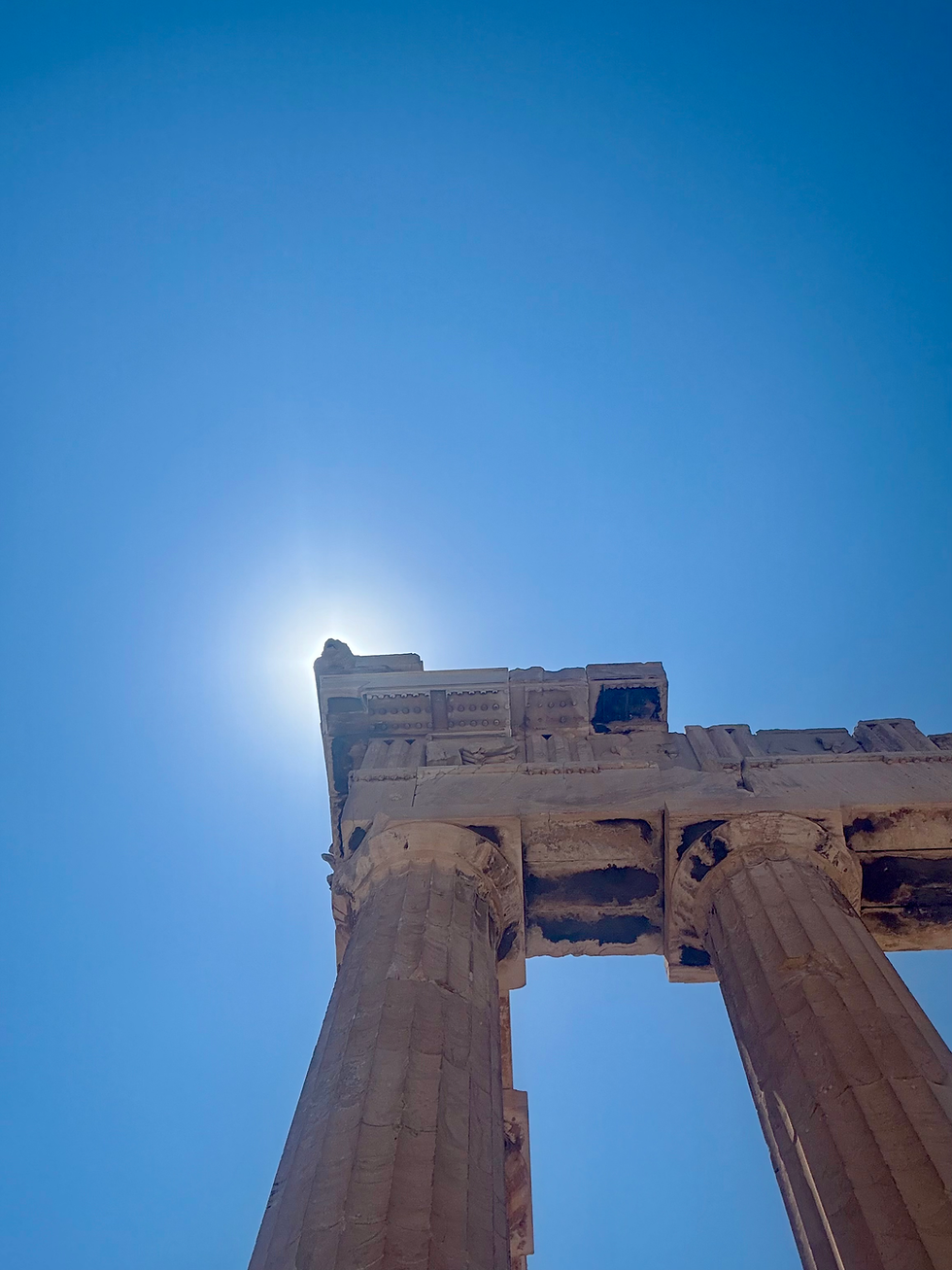Athens or Shall We Say CAThens?
- Amy Digges
- Jul 8
- 9 min read
Updated: Jul 17
I’m not sure what I expected from Athens. Maybe something like Rome — all ancient bones and somber shades of gray. I pictured crumbling ruins, streets worn thin by centuries, maybe a faint air of grit clinging to the city like the dust of history itself.
However, the small slice of Athens we experienced — the pedestrian-friendly neighborhood around the Acropolis and the Plaka district — was unexpectedly bright, light, and full of energy. Think cobbled streets lined with lively cafés, vibrant shopfronts, and a surprising amount of greenery tucked between the ruins and draped over white walls in graceful blooming arches.


Our home base was an apartment right along the pedestrian walkway.

Now, I should mention that my decision-making process for booking accommodations was not based on reviews, square footage, or views of the Parthenon. No, I chose the apartment entirely because of the wall art — a painted gallery of stoic cats dressed in full formal regalia: waistcoats, turbans, military sashes, the works. Sometimes you just have to make a decision and go with it.
Athens: It’s almost impossible to comprehend. The stones beneath your feet are smoothed by thousands of years of footsteps — merchants, philosophers, artists, conquerors, and now, tourists like us. At times, I found myself reaching down to touch the marble near the ruins, tracing its polished surface and marveling at how time itself can carve stone.
Here’s another surprise. The weather. London had been humid and muggy, yet here in Athens, the dry air and steady breeze made wandering the city surprisingly comfortable — even with the relentless Greek sun beating down on the ruins. Shade or sun, you could always find a pocket of cool.
Our first morning, we wandered just six minutes down the street to the Acropolis Museum, an absolute must before tackling the actual ruins. Perched at the foot of the Acropolis hill, the museum is a sleek, modern contrast to the ancient treasures inside. Glass floors reveal excavations below, while marble statues, crushed paint pigments from stones like lapis lazuli, exquisitely detailed, hand painted amphoras with scenes of mythology, and impossibly delicate figurines fill the airy space inside.
The artistry and detail work without the use of modern tools astounds me every time, especially when it comes to depicting the delicate folds of fabric in marble. To carve something so light and transparent with something as hard and solid as marble is incomprehensible.
One of the museum’s unexpected highlights? Liam pointed, “Look it’s Quinn!” There, carved in perpetuity was a slightly more aloof Ancient Greek (with curly hair and no glasses.) He stood there, immortalized in marble, slightly slouched, hands shoved nonchalantly in his pockets (or the toga equivalent), a pose we’ve seen Quinn perfect a hundred times. Sadly, the museum has a strict no-photos policy in certain parts of the museum, so you’ll just have to picture Quinn’s Greek equivalent.

Getting to the Acropolis itself is equal parts short hike, history lesson, and nature walk. The path winds upward past olive and cypress trees, sunlight dappled across weathered stone and crumbling columns. Along the way, we paused at the Theatre of Dionysius, the oldest surviving theater in the world — where, fittingly, drama itself was born. Imagine standing where audiences once watched the first plays of Euripides and Sophocles. Today, audiences watch performers while seated on those same ancient marble benches.

As we continued to climb, the marble underfoot turned slippery with age, worn smooth by millions of visitors before us.

The higher we went, the stronger the breeze — like the Acropolis itself rewarding you for your efforts.
We passed towering marble columns and the replicated caryatids — graceful, stone-carved figures poised high above Athens, their cream colored forms gleaming against the sharp blue of the sky.

At the summit? The crown jewel of Athens: the Parthenon.

Taller than I imagined, impossibly grand, and still standing after earthquakes, invasions, looters, and centuries of time trying to chip away at its edges.

Built between 447 and 432 BC, this temple dedicated to Athena — goddess of wisdom and warfare — is the ultimate symbol of ancient Greek civilization.

Sure, the scaffolding reminds you that the Parthenon is still in a perpetual state of restoration, but it doesn't matter. Standing there, wind whipping around you, with panoramic views of all Athens stretching to the Aegean Sea — it's humbling, awe-inspiring, and surreal.
Liam had the clever idea to reenact a few mythological stories at Grecian sites along our trip. This one is called the “Naming of Athens” and here is the story…
Long ago, when the city of Athens was nothing but rocky hills and olive groves, the gods decided it needed a protector — and two mighty Olympians both wanted the honor.
First came Poseidon, god of the sea, riding his powerful white horse, its hooves striking sparks on the stone. With a mighty blow of his trident, he struck the ground, and from the rock burst a spring of water. But when the people rushed to drink, they found the water was salty.
Next came Athena, goddess of wisdom and war. She planted a small, silvery olive tree, and told the people, “This tree will give you wood for shelter, oil for cooking, and fruit for food.”
The people considered both gifts: Poseidon's wild, powerful spring of saltwater… and Athena's humble olive tree, promising peace, prosperity, and growth.
In the end, they chose Athena's gift — practical and lasting. The city took her name, and Athens has belonged to the goddess of wisdom ever since — with olive trees still standing as her symbol of victory. To help you decipher the photo, Liam - the salt spring, Quinn - the olive tree, Gaelan - a defeated Poseidon, Kip - Poseidon’s rearing horse, and Onora - Athena herself, looking strong and proud.

That evening, we wandered just around the corner to a souvlaki stand. The chef was part culinary master, part Soup Nazi, barricaded in his tiny, sweltering kitchen, barking orders in exasperated, broken English.
“No, no! You! Stand here! Pick up order here!” he shouted, pointing wildly, as bewildered tourists scrambled to obey. It became a game of survival — follow the rules, don’t anger the souvlaki god, and maybe you’ll earn your dinner.
Behind the counter, he wielded a metal contraption that looked more suited for taming burly beards than preparing food, shaving thin, juicy strips of meat straight from the rotating leg of—well, something once furry and four-legged. By that point, its origins were entirely unrecognizable, glistening juices dripping into a pan below.
I’ve never been one for witnessing the full circle of life when it comes to my meals — I prefer my food to magically appear on a plate, origins unspoken — so I slipped quietly to a table and let the carnivores handle the process.


The following day, we woke early, and hopped in our rented car that came straight to our door (now, that’s service!) and headed out of town, carefully trying to navigate the tiny, yet bustling streets of Athens in a manual car.
Side note: The number of cars that can fit on an ancient street here is a mystery of physics. Add the motorcycles to the mix, who follow no rules, and you have a potentially deadly obstacle course disguised as “morning traffic.”

Two and a half hours later, after winding through dry, sun-baked hills far beyond the city, we arrived at our first stop: Arachova.

As soon as we entered the town limits, I was smitten with this little mountain hamlet that overlooks legendary Mt. Parnassus.

We found a small taverna, still sleepy from the day before and had an “early bird” lunch, somehow being the only people in the restaurant at 1:00pm.

We were seated on the balcony, overlooking the terracotta roofs of the town and hills beyond while the wind snapped the canvas awning above our heads, forcing us to hold down what wasn’t nailed.


We settled in to eat a delicious lunch of Moussaka, Veal, Souvlaki, and Pasta Neapolitan.

I’ve never liked eggplant in my life and that’s not from a lack of trying. But, I can officially say I am now an eggplant convert, at least in the way the Greeks make it.
With the sun still high in the sky, we arrived at Delphi and began our visit in the museum, home to the astonishing treasures unearthed from the ancient sanctuary.
Some of the statues were so detailed, so eerily lifelike, I found myself thinking — if one of them reincarnated and strolled past me on the street today, I might just recognize them. Their features, carved in marble thousands of years ago, felt familiar — proof that faces change, but humanity doesn’t. I felt particularly charmed by the small face on the left.

Long before the Oracle of Delphi became the center of ancient prophecy, Delphi was guarded by a fearsome dragon-like serpent called Python. Legends say that Python had harassed Apollo’s mother Leto, forcing her to forever wander the earth.
Enter Apollo, young and radiant, and slightly vengeful after the treatment of his Mother.
Armed with his golden bow and arrows, he descended upon Delphi, tracking Python through the rocky landscape and, after a fierce battle, struck him down.
With Python defeated, Apollo claimed the site as his own and founded the Oracle of Delphi, appointing the Pythia, the priestess who would speak in his name, as the official mouthpiece of divine prophecy. Interestingly, the name "Pythia" comes directly from Python, as a reminder of the ancient serpent who once ruled the land.
In accordance with Liam’s reenactment plans, we set the stage for the story of Apollo (Liam) riding his chariot (Kip) pulled by swans (Onora and Gaelan) to defeat Python the dragon-serpent (Quinn) at the top of Mt. Parnassus.

For nearly a thousand years, the Oracle of Delphi was considered the most powerful and sought-after source of prophecy in the ancient world. Kings, generals, philosophers, and even ordinary citizens climbed the slopes of Mt. Parnassus to visit the sanctuary of Apollo and seek guidance from the Pythia, the priestess who served as the voice of the famed god.
Interestingly, those who traveled to Delphi in search of divine guidance were rarely handed a straight answer. The Oracle’s prophecies — spoken by the priestess in a trance — were famously cryptic, more like riddles wrapped in poetry than clear instructions. For example, If the ruler of Persia wanted to attack Greece and came to ask the Oracle if his campaign would be successful, the answer might be something like, “A great empire will fall.”
“Ah, thanks for your…help?”


As we stood there imagining ancient kings and weary travelers climbing the same mountain in search of their fate, Liam summed it up perfectly:
“Can you imagine coming all this way, finally asking your big question… and then not even understanding the answer?” I mean, it’s not an easy trek and we just came from the parking lot! Some came from other parts of Greece…on foot.
Some came bearings gifts to the priestesses of Delphi. The largest gifts gave the visitor priority. It’s essentially a “skip the line” pass.Picture all of those visitors, standing in line for days to receive their prophecy, like an ancient version of the line at Space Mountain. In their hands, they clutch their small trinket to present to the oracle. Suddenly, some guy rolls up with an enormous sphinx statue and cuts in front. “Hey, man, I was here first!”



Even Alexander the Great came to seek counsel at the oracle. According to legend, when the Pythia wouldn’t give him a prophecy, he dragged her outside the temple, prompting her to exclaim, “You are invincible.” This simple, yet effective statement gave Alexander the proverbial green light to continue conquering and pillaging. Tip: If you don’t like the answer that is given, torture them until they give you something more to your liking.

Another two hour drive brought us back to Athens for our final night. The Parthenon glows white against the dark sky, illuminated by powerful spotlights like a beacon over the city.

We wander the breezy streets, where the clink of silverware mingles with the hum of conversation in a dozen languages.

Shops spill open, musicians strum soulful Greek melodies, and the ever-present cats of Athens weave through the crowds as if they own the place—which, in a way, they do.

This is where Onora’s ritual begins: “The Naming of the Cats.” With each feline we pass, she carefully chooses a name and continually lists them aloud Flicker, Flitter, Flame, etc. While it seems she has a penchant for alliteration, there are plenty more that don’t start with an “F”…like “Garlic”. Like an ancient scribe, she comes home and, in her little brown sketchbook, lists each cat’s name, description, and, miraculously, their gender.
And that’s our little slice of Athens. Athens is a city where history isn’t tucked behind glass or roped off in museums — it’s beneath your feet, woven into the streets, and etched into every worn stone you pass. Where you can ponder democracy, mythology, and the birthplace of theater… all before heading home to an apartment guarded by cats in waistcoats.
Off to Naxos next…

































































































Comments